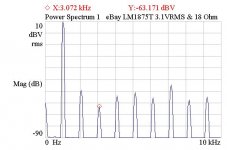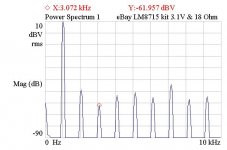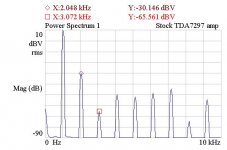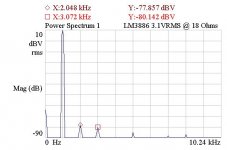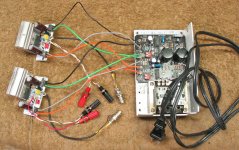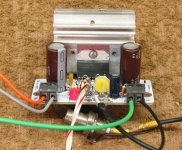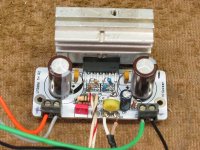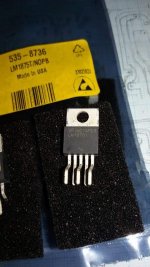From Jameco
Please note the top has a bevel or chamfer around the top where the marking is made, it is not a sharp edge.
There is a site selling Kiton brand stuff, and he says the fake chips don't have bevelled front or top edges like the original, and the markings are different with regard to lettering, location in the print area and so on.
ST puts factory location and batch number/date code too, not sure about NS.
And Mouser photos here show chips marked TI, which are supposedly non existent, maybe new production.
Confusing
Please note the top has a bevel or chamfer around the top where the marking is made, it is not a sharp edge.
There is a site selling Kiton brand stuff, and he says the fake chips don't have bevelled front or top edges like the original, and the markings are different with regard to lettering, location in the print area and so on.
ST puts factory location and batch number/date code too, not sure about NS.
And Mouser photos here show chips marked TI, which are supposedly non existent, maybe new production.
Confusing
Last edited:
The chip in your first photo does not have bevelled edges either, so according to some it is doubtful too.
I checked on my data sheet, but it is an old one.
There is a chamfer or bevel on the top, at the border of the printed surface, the corner is not sharp.
I checked on my data sheet, but it is an old one.
There is a chamfer or bevel on the top, at the border of the printed surface, the corner is not sharp.
Last edited:
Here bulk price of cheapest 1875 from Mouser in 100+ quantity is 161.03 Rupees each, a little over 2 US dollars.
Chinese ones are 8 to 12 Rupees in single quantity.
1 to 1.5 cents of US currency.
That is a big difference, and so a big incentive for cheats selling fake parts.
Chinese ones are 8 to 12 Rupees in single quantity.
1 to 1.5 cents of US currency.
That is a big difference, and so a big incentive for cheats selling fake parts.
Last edited:
Yesterday I posted a badly-distorted spectra for the "fake" LM1875T that came with a kit from China. Today I installed the Zobel networks on the board, and re-measured. Either that fixed something, or else I had made some kind of mistake yesterday, because that same amp is measuring fine today. I fact, it measures pretty much identical to the one I bought from Digikey. Is it actually an LM1875? I can't say. It doesn't have the same "wrinkles" at high frequencies in the falling edge of the square wave. It's actually a better-behaving chip in that respect. But it is not, as I called it, a "piece of junk". Here's the new spectra.
I'm going to assemble one of the China kits and see how it works on that board. Not expecting anything different, but it's here, so why not...
I'm going to assemble one of the China kits and see how it works on that board. Not expecting anything different, but it's here, so why not...
Attachments
Fini
OK, just to put some closure on this. Here is the LM8715 eBay kit with its supplied chip, set up identically to the board I've been testing on.
As you can see, there is absolutely no difference between it and the "legit" LM1875 bought from Digikey, installed on the other board, which supposedly has a better layout.
And with that, my interest in the LM1875 ends.
OK, just to put some closure on this. Here is the LM8715 eBay kit with its supplied chip, set up identically to the board I've been testing on.
As you can see, there is absolutely no difference between it and the "legit" LM1875 bought from Digikey, installed on the other board, which supposedly has a better layout.
And with that, my interest in the LM1875 ends.
Attachments
Two days ago I received this TDA7297 board:
TDA7297 15W Version B Digital Audio Amplifier Board AC/DC 12V Dual-Channel Hot | eBay
I have bought from this seller several times, they are honest folks and good to work with.
This board is a different mix of compromises from other 7297's I've seen on DIYA. First I tested it in stock form using a 12V 1 Amp Power One modular linear supply. With diff outputs this chip does not like either side to be grounded, so I could not do any scope tests. My HP analyser can float its input ground so I was able to do THD. At 3.1V RMS into 18 Ohms, the distortion spectrum is MUCH better than the LM1875. Predominantly 2nd order @ -40dB, very little 3rd order (-75dB). At 10kHz it was the same, but 3rd order came up a few dB. Not bad, but not great. This little thing won't win any purity contests but should be a musical-sounding amp.
After testing, I removed the caps and diode. The 100nF ceramic bypass cap is junk and got tossed. Probably not needed, anyway. The 2200uF/50V 'lytic is plenty good, measuring 2050 uF @ 1kHz with 26 mOhm ESR, so I put it back in. The supplied 220nF input coupling caps are miniature polyester films, measuring 0.01 DF at 10kHz, quite typical of polyester/mylar film types. Not SOTA but much better than cheap ceramics. So I put those back and added a 1uF WIMA film to them on the back of the board. The level pot has good feel and interchannel tracking is good enough, so I left it.
What's wrong with this board is a haphazard grounding scheme, connecting SG and PG midstream, with the 2200uF cap on the SG arm, and the pot on the PG arm. Correctable with wire, but sloppy layout.
I hooked the amp into my headphone system and listened to a few things. Pretty decent. Reasonable bass, hints of depth/soundstage, still forward-sounding, but not nearly as edgy/irritating as the LM1875 was. I do wish the gain was not fixed at 32dB. Lowering it would probably help matters.
I'll replace the 12V @ 1A supply with a 15V @ 1.5A for more headroom, fix the grounding issues, and give it another listen.
TDA7297 15W Version B Digital Audio Amplifier Board AC/DC 12V Dual-Channel Hot | eBay
I have bought from this seller several times, they are honest folks and good to work with.
This board is a different mix of compromises from other 7297's I've seen on DIYA. First I tested it in stock form using a 12V 1 Amp Power One modular linear supply. With diff outputs this chip does not like either side to be grounded, so I could not do any scope tests. My HP analyser can float its input ground so I was able to do THD. At 3.1V RMS into 18 Ohms, the distortion spectrum is MUCH better than the LM1875. Predominantly 2nd order @ -40dB, very little 3rd order (-75dB). At 10kHz it was the same, but 3rd order came up a few dB. Not bad, but not great. This little thing won't win any purity contests but should be a musical-sounding amp.
After testing, I removed the caps and diode. The 100nF ceramic bypass cap is junk and got tossed. Probably not needed, anyway. The 2200uF/50V 'lytic is plenty good, measuring 2050 uF @ 1kHz with 26 mOhm ESR, so I put it back in. The supplied 220nF input coupling caps are miniature polyester films, measuring 0.01 DF at 10kHz, quite typical of polyester/mylar film types. Not SOTA but much better than cheap ceramics. So I put those back and added a 1uF WIMA film to them on the back of the board. The level pot has good feel and interchannel tracking is good enough, so I left it.
What's wrong with this board is a haphazard grounding scheme, connecting SG and PG midstream, with the 2200uF cap on the SG arm, and the pot on the PG arm. Correctable with wire, but sloppy layout.
I hooked the amp into my headphone system and listened to a few things. Pretty decent. Reasonable bass, hints of depth/soundstage, still forward-sounding, but not nearly as edgy/irritating as the LM1875 was. I do wish the gain was not fixed at 32dB. Lowering it would probably help matters.
I'll replace the 12V @ 1A supply with a 15V @ 1.5A for more headroom, fix the grounding issues, and give it another listen.
Attachments
Sorting out the ground issue and having a bit more power behind it gave it a bit more solid bass and cleaned up a little of the congestion in the mids. Not world-class, but pretty remarkable what a 3 buck amp can do. Much more musical than the LM1875. I can live wih this until I have something better ready.
Next up is a TDA7293 board from dibya/jhofland/xrk. That looks very promising at the low power levels needed here. And a 'minimalist' LM3886 board that looked interesting from a guy in FL. And then a set of JLH1969 boards on order from China. Should be fun.
Next up is a TDA7293 board from dibya/jhofland/xrk. That looks very promising at the low power levels needed here. And a 'minimalist' LM3886 board that looked interesting from a guy in FL. And then a set of JLH1969 boards on order from China. Should be fun.
First listen to a pair of the hifiocean LM3886 boards driving the Fontek headphones, and it's very impressive. Compared to the TDA7293 amps I'd been tweaking and listening to the prior couple of days, the 3886 is just as clean and transparent-sounding but with a warmer overall sound and more authoratative bass. So as of now, it's on top of the heap for potential amps to drive these phones.
Over the weekend I'm going to see if I can lower the gain 6-8dB and keep it stable. Something around 16dB gain would be about right.
Over the weekend I'm going to see if I can lower the gain 6-8dB and keep it stable. Something around 16dB gain would be about right.
Thank you for positive feedback 🙂it's very impressive. Compared to the TDA7293 amps I'd been tweaking and listening to the prior couple of days, the 3886 is just as clean and transparent-sounding but with a warmer overall sound and more authoratative bass. So as of now, it's on top of the heap for potential amps to drive these phones.
The distortion can be even lower. Did you measure with a volume control pot connected? Do you mind posting a photo of your setup?Harmonic distortion is around .005%, in good agreement with TI's spec.
Last edited:
Thank you for positive feedback 🙂
So you're the one responsible for this, eh... well done 🙂
The distortion can be even lower. Did you measure with a volume control pot connected? Do you mind posting a photo of your setup?
Yes, volume control is connected. It can not be removed in this application. Will post a photo later.
I have been listening to this setup now for 3-4 days and it really sounds excellent. The Fontek headphones are very revealing of differences especially in the critical midrange.
Last edited:
Do you mind posting a photo of your setup?
Here are pics of the test setup. Now to find a suitable enclosure. The trimmer pots will get replaced with a dual-ganged 10k audio taper on the front panel.
A note on the power supply: I have been scavenging linear supplies like this one from various industrial gear for decades, but never thought of using them for an audio project. I recall seeing one powering a Sound Technology recording console back in the 90's but poo-poohed it as a choice of convenience.
Well it turns out, jumpered for local rail and ground sensing, they are quite good. LM723 regulators with TO3 pass transistors result in an output impedance of less than 5mOhm at the output terminals up to 20kHz. And that is with 40-year-old capacitors. With the wiring and onboard caps shown, it measures flat 26mOhm to 20kHz at the amp bypass caps. That is hard to beat.
Attachments
The power supply looks great! It is good to have something like that in stock instead investing the same wheel every time. It is not often that you see LM3886 running from +/-15V, but it is well within its specs.
As for the slightly higher distortion, the main suspect is the little wire from the wiper of the trimpot to R1. Once you move the trimpots out and revert to the PCB traces, the distortion should go down a bit.
Also, it is better to twist together V+/PG+ and V-/PG- pairs of power supply wires. Each pair carries essentially a rectified half of the output current, rich in higher harmonics, and if such a pair forms a loop, those harmonics will inductively couple back into the input and feedback networks. Twisting wires together reduces the coupling effect and measurably reduces distortion. In your case, the effect should be somewhat less pronounced as the power rails are lower and the load impedance is higher, which reduces the supply currents.
Congratulations on the nice build! Would be interesting to see the completed amplifier once you put it into a permanent enclosure.
As for the slightly higher distortion, the main suspect is the little wire from the wiper of the trimpot to R1. Once you move the trimpots out and revert to the PCB traces, the distortion should go down a bit.
Also, it is better to twist together V+/PG+ and V-/PG- pairs of power supply wires. Each pair carries essentially a rectified half of the output current, rich in higher harmonics, and if such a pair forms a loop, those harmonics will inductively couple back into the input and feedback networks. Twisting wires together reduces the coupling effect and measurably reduces distortion. In your case, the effect should be somewhat less pronounced as the power rails are lower and the load impedance is higher, which reduces the supply currents.
Congratulations on the nice build! Would be interesting to see the completed amplifier once you put it into a permanent enclosure.
The power supply looks great! It is good to have something like that in stock instead inventing the same wheel every time.
I agree! Coming from industrial equipment, I had assumed they were reliable supplies, but so-so performers. But I was very wrong on the latter.
As for the slightly higher distortion, the main suspect is the little wire from the wiper of the trimpot to R1. Once you move the trimpots out and revert to the PCB traces, the distortion should go down a bit.
Hmmm, very interesting call. I'll follow up on that when it's installed. BTW, R1 is actually jumpered out on the bottom as it isn't needed. The pot will never be used wide-open, so the output restance from the 10k pot is and will always be more than 1k.
Also, it is better to twist together V+/PG+ and V-/PG- pairs of power supply wires. Each pair carries essentially a rectified half of the output current, rich in higher harmonics, and if such a pair forms a loop, those harmonics will inductively couple back into the input and feedback networks. Twisting wires together reduces the coupling effect and measurably reduces distortion. In your case, the effect should be somewhat less pronounced as the power rails are lower and the load impedance is higher, which reduces the supply currents.
Agreed, and they will be twisted in the final install. It's not done here because twisting makes the wires even stiffer than they already are, and I needed some freedom of movement while still experimenting with it.
Congratulations on the nice build! Would be interesting to see the completed amplifier once you put it into a permanent enclosure.
Thanks. I don't anticipate it will win any beauty contests, the plan is to stuff it into one of the old enclosures I've collected over the years.
The chip in your first photo does not have bevelled edges either, so according to some it is doubtful too.
I checked on my data sheet, but it is an old one.
There is a chamfer or bevel on the top, at the border of the printed surface, the corner is not sharp.
This is a genuine LM1875(new production), very sure. The photo you have posted i've never seen a lm1875 with that type of marking

Attachments
Last edited:
I copied the photo from the Jameco site, they sell components online, that was mentioned in my post.
I also mentioned that Mouser India has photos on their site with chips marked Texas Instruments, which is either a goof up or that TI is changing the markings, earlier they had kept the NS marking alive after taking over NS.
I also said this was confusing.
So what is your point in the above post?
The thing is that there are many locations where the chips are made by the same company, and each company has its own marking system, and due to changes in planning and sometimes to counter fakes, the markings and shape change.
jbau finally got around to telling us how it sounded, and the rest of the discussion has been about the chip, and other chip amps.
So after getting your chip, did you make an amp and use it?
Tell us about it.
I also mentioned that Mouser India has photos on their site with chips marked Texas Instruments, which is either a goof up or that TI is changing the markings, earlier they had kept the NS marking alive after taking over NS.
I also said this was confusing.
So what is your point in the above post?
The thing is that there are many locations where the chips are made by the same company, and each company has its own marking system, and due to changes in planning and sometimes to counter fakes, the markings and shape change.
jbau finally got around to telling us how it sounded, and the rest of the discussion has been about the chip, and other chip amps.
So after getting your chip, did you make an amp and use it?
Tell us about it.
Last edited:
The point is i am not prepared to accept that a counterfeit/faulty-rejected IC will give almost the same performance as a real one. It's not possible, technically or sonically. Fake LM1875 costs very little compared to a real one, ₹25 vs. ₹280 !
I have used almost all the popular chipamps
(Tda2003/2005/7297/2030A/2050/1557/7293/94, Lm1875,1876,3886 and many more) and in my experience the original parts have always given much better performance than a fake one. Some Chinese copies are good but you can only find them in some inexpensive computer speakers or subwoofer system; like D1875/D2030A etc. All chipamp has different sonic qualities and intended for different duties, as a example Tda1557q was designed for car audio, not for home entertainment. I don't think lm1875 is suitable for a headphone amp but a good one for home stereos or subwoofer system.
I have used almost all the popular chipamps
(Tda2003/2005/7297/2030A/2050/1557/7293/94, Lm1875,1876,3886 and many more) and in my experience the original parts have always given much better performance than a fake one. Some Chinese copies are good but you can only find them in some inexpensive computer speakers or subwoofer system; like D1875/D2030A etc. All chipamp has different sonic qualities and intended for different duties, as a example Tda1557q was designed for car audio, not for home entertainment. I don't think lm1875 is suitable for a headphone amp but a good one for home stereos or subwoofer system.
That conclusion was reached by jbau, that the real and fake chips sounded close.
Also, he was the one looking for a suitable headphone amplifier.
Please don't involve me... I simply said that the price difference was attractive for sellers of fakes, which happens a lot on AliExpress it seems.
Also I replaced 2 NEC uPC 1238 with one each branded Chinese 1875 and 2030, both were 15 Rupees here, still in that range last I asked.
My real argument was that given a choice of fake marked chips and copied chips, it was easier to put a branded copy, at least it is known to be a copy. So your expectations are not high.
And some like 810 amp, and 1619 FM chip are not made any more by the original maker.
Then the choice is to repair with branded copy, or scrap an otherwise good unit.
By the way, what did you do with the chip you bought for Rs. 280?
Also, he was the one looking for a suitable headphone amplifier.
Please don't involve me... I simply said that the price difference was attractive for sellers of fakes, which happens a lot on AliExpress it seems.
Also I replaced 2 NEC uPC 1238 with one each branded Chinese 1875 and 2030, both were 15 Rupees here, still in that range last I asked.
My real argument was that given a choice of fake marked chips and copied chips, it was easier to put a branded copy, at least it is known to be a copy. So your expectations are not high.
And some like 810 amp, and 1619 FM chip are not made any more by the original maker.
Then the choice is to repair with branded copy, or scrap an otherwise good unit.
By the way, what did you do with the chip you bought for Rs. 280?
Last edited:
That conclusion was reached by jbau, that the real and fake chips sounded close.
Actually, I said I had no way of knowing whether the one from China is a fake or not. I said the distortion measures virtually identical on both, and the supposed "fake" had cleaner transient response. Because of the latter, I'm going to use the "fake" for a low-power amp for my test bench, for those times when a low-impedance source is needed.
Let's not make this thread about LM1875, there are plenty of others for that.
- Home
- Amplifiers
- Chip Amps
- Complete chip amp kit with enclosure, etc ?

